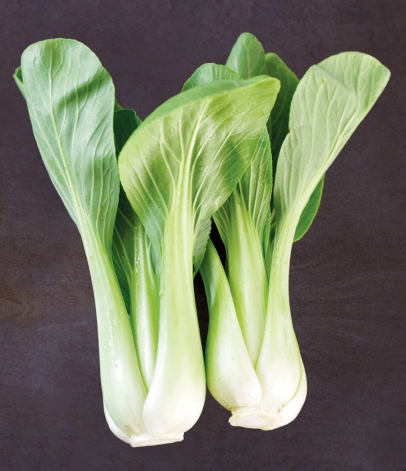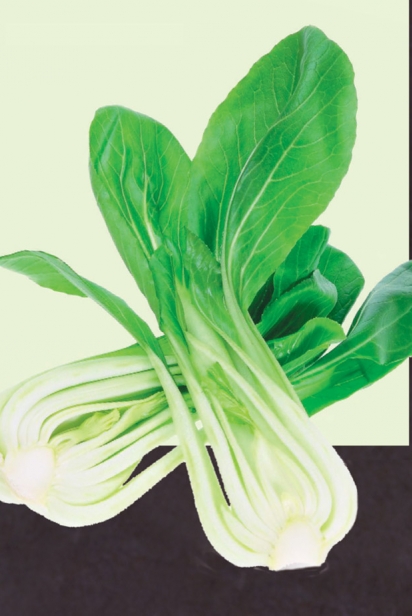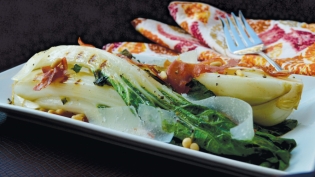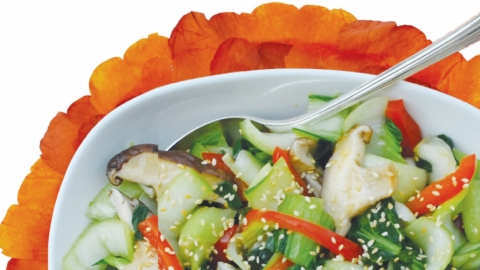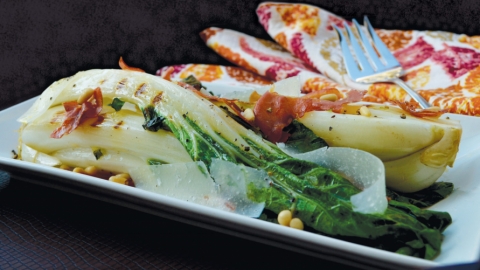Bok Choy: A Good Choy-ce
Bok choy is a green worth knowing.
An Asian staple for centuries, bok choy grows here in endless rows of ivory stalks that fan out like gusseted tutus, forming tight bouquets hemmed with vibrant green leaves. They eagerly burst from the soil, reaching for the sky, with fortitude and sheer charisma.
With its satisfying crunch and distinct verdant flavor, bok choy is unlike its nippy and pungent mustard-family cousins. Depending on the variety, its stalks can range from pure white to deep green to yellow, with purple to dark green leaves. While it is popularly consumed as a baby green, many varieties are delicious and beautiful when mature.
This nutrient-dense, low-cal green offers an excellent source of vitamins A, C and K, along with minerals, delivered with a distinctively crisp yet tender mouthfeel with a juicy finish.
It’s typically a fall-into-winter crop because it likes it a little cooler, says Jason Cheng of Yao Cheng Farm in Camarillo, which grows organic bok choy. “In spring and summer it flowers too quickly due to heat and timing,” he says. However, “Ventura County has an ideal range of temperature that lets it grow year round.”
After a slow initial introduction through the Ventura County farmers’ market scene in the early 1990s, the formerly niche-market vegetable has entered the local restaurant landscape and home kitchens.
“While bok choy used to be something you could only order at a Chinese restaurant, we are seeing it pop up on menus at many mainstream restaurants and fast-casual locations, giving consumers the opportunity to try these greens in nontraditional ways,” says Megan Ichimoto, marketing supervisor at San Miguel Produce. The 41-yearold Oxnard farm also produces washed and ready-to-use bok choy under the brand Jade Asian Greens.
Also known as pac choy, pak choi and by numerous other spellings, it’s a type of Chinese cabbage whose greens can be eaten raw in salads, or stir-fried, braised, steamed, sautéed or simmered in soup. You can even add bok choy to green smoothies or juices.
As one of the most widely used Asian greens, “the nutrient density and culinary versatility make bok choy a great ingredient in many dishes,” says Ichimoto.
Bok choy is also great for sustainable agriculture. When used as a cover crop or rotated with alternative crops, bok choy can offer an eco-friendly nitrogen sink for farmers. Its quick growing cycle and high demand for nitrogen make it a perfect candidate to take up excess nitrogen in the soil, which reduces nitrogen runoff .
“We usually let our bok choy flower, then chop it into the soil, and I also use it as a barrier,” says Cheng. His family farm produces organic bok choy for us to cook with and also grows it as a cover crop. “We have been doing [crop rotation] since we have been here; our soil health is very good,”
“Within the last couple of years, I definitely have seen a rise in people buying bok choy, and experimenting with it,” adds Cheng. “It’s a staple for Asian families, so it definitely won’t go anywhere, and it will stick around for famers’ markets, for sure.”
Next time you spot the crisp, lively greens at a local market, grab a bunch for the perfect addition to your meal and try the recipes from Moez Megji, chef and co-owner of The Gallery in Westlake Village.
Getting to know Local Bok Choy
The wealth in diversity of bok choy offers many options for color, texture, taste and size. Here are a few the most popular varieties grown locally.
Shanghai Bok Choy
Sweet and mild, Shanghai bok choy has smooth leaves and green leaves and stems. Delicious sautéed, steamed or even grilled, Shanghai bok choy is popular in restaurants.
Butter Bok Choy
This white-stemmed bok choy is a favorite in Asian cuisine and among farmers, with crispy spoon-shaped stems and dark green glossy leaves. With a slight mineral flavor, it can be used raw for salad or cooked.
Baby Bok Choy
A consumer favorite, this single-serving-size tender green is harvested young. It’s perfect for restaurants and small dishes, as it easily takes on flavors. With its mild taste and uniform production, this small plant packs a pleasantly crunchy stem and tender spinach-like green leaves.


